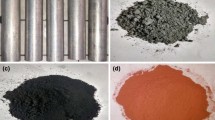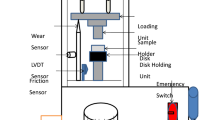Abstract
In this work, AA7075 ˗ SiC (0–8 wt.% @ step of 2%) / marble dust (8–0 wt.% @ step of 2%) / graphite (3 wt.%) hybrid alloy composites have been designed and fabricated via high vacuum casting method as per standard procedure, leading to five samples namely SM-08, SM-26, SM-44, SM-62, SM-80 respectively. Thereafter, possible synergistic impact of the complementary combination of SiC/marble dust reinforcing particulates on physical, mechanical, and sliding wear performance of hybrid alloy composites were investigated followed by surface morphology studies. Taguchi approach has been used for sliding wear parametric optimization and hybrid ENTROPY-VIKOR decision-making technique is used for ranking of material based on performance measures. It is observed that with the reinforcing phase the properties like wear performance, coefficient of friction, density, voids content, compressive strength, and impact strength of composites increases considerably while flexural strength diminishes. Thus, SM-62 alloy composite (having 6 wt.% SiC, and 2 wt.% marble dust) shows better improved overall performance relative to others.
Similar content being viewed by others
Data Availability
Additional data available on reasonable request by email to the corresponding author.
References
Wang DZ, Peng HX, Liu J, Yao CK (1995) Wear behavior and microstructural changes of SiCw-Al composite under unlubricated sliding friction. Wear 184:187–192
Harris SJ (1988) Cast metal matrix composites. Mater Sci Technol 4:231–239
Chen W, Liu Y, Yang C, Zhu D, Li Y (2014) (SiCp+ Ti)/7075Al hybrid composites with high strength and large plasticity fabricated by squeeze casting. Mater Sci Eng A 609:250–254
Prabu SB, Karunamoorthy L (2008) Microstructure-based finite element analysis of failure prediction in particle-reinforced metal–matrix composite. J Mater Process Technol 207:53–62
Kumar A, Patnaik A, Bhat IK (2017) Investigation of nickel metal powder on Tribological and Mechanical Properties of al7075Alloy Composites for Gear Material, journal of. Powder Metall 60:371–383
Kumar KR, Kiran K, Balaji VS (2017) Micro structural characteristics and mechanical behavior of aluminium metal matrix composites reinforced with titanium carbides. J Alloys Compd 723:795–801
Kumar KR, Kiran K, Sreebalaji VS (2017) Characterization of mechanical properties of aluminium/tungsten carbide composites. Meas 102:142–149
Alhawari KS, Omar MZ, Ghazali MJ, SallehMS MMN (2013) Wear properties of A356/Al2O3 metal matrix composites produced by semisolid processing. Procedia Eng 68:186–192
Kiran TS, Kumar MP, Basavarajappa S, ViswanathaBM (2014) Dry sliding wear behavior of heat treated hybrid metal matrix composite using Taguchi techniques. Mater Des 63:294–304
Kumar A, Kumar A (2020) Mechanical and dry sliding wear behavior of B4C and rice husk ash reinforced Al 7075 alloy hybrid composite for armors application by using Taguchi techniques. J Mater Today: Proc 27:2617–2625
Bhaskar S, Kumar M, Patnaik A (2019) Application of hybrid AHP-TOPSIS technique in analyzing material performance of sil- icon carbide ceramic particulate reinforced AA2024 alloy compos- ite. Silicon. 12:1075–1084
Kumar M, Kumar A (2020) Application of preference selection index method in performance based ranking of ceramic particulate (SiO2/SiC) reinforced AA2024 composite materials. J Mater Today: Proc 27:2667–2672
Singh T, Patnaik P, Fekete G, Chauhan R, Gangil B (2019) Application of hybrid analytical hierarchy process and complex proportional assessment approach for optimal design of brake friction materials. Polym Compos 40:1602–1608
Satapathy BK, Majumdar A, Tomar BS (2010) Optimal design of flyash filled composite friction materials using combined analytical hierarchy process and technique for order preference by similarity to ideal solutions approach. Mater Des 31:1937–1944
Maniya K, Bhatt MG (2010) A selection of material using a novel type decision –making method: prefence selection index method. Mater Des 31:1785–1789
Maniya KD, Batt MG (2011) An alternative multiple attribute decision making methodology for solving optimal facility layout design selection problems. Comput Int Eng 61:542–549
Jahan A, Kevin L, Edwards MB (2016) Multi criteria decision analysis for supporting the selection of engineering materials in product design .Butterworth-Heinemann. https://doi.org/10.1016/C2012-0-02834-7
Aherwar A, Patnaik A, Bahraminasab M, Singh A (2017) Preliminary evaluations on development of new materials for hip joint femoral head. Mater Des App https://doi.org/10.1177/1464420717714495
Kumar M, Kumar R, Tak Y, Meena RK, Sharma N, Kumar A, Parametric optimization and ranking analysis of hybrid epoxy polymer composites based on mechanical, thermo-mechanical and abrasive wear performance(2020)High Perform. Polym https://doi.org/10.1177/0954008320959412
Kumar A, Patnaik A, Bhat IK (2019) Tribology analysis of cobalt particulate filled Al 7075 alloy for gear materials: a comparative study. Silicon 11:1295–1311
M.Kumar (2020) Mechanical and Sliding Wear Performance of AA356-Al2O3/SiC/Graphite Alloy Composite Materials: Parametric and Ranking Optimization Using Taguchi DOE and Hybrid AHP-GRA Method, Silicon https://doi.org/10.1007/s12633-020-00544-9
Bhaskar S, Kumar M, Patnaik A (2019) Silicon carbide ceramic particulate reinforced AA2024 alloy composite - part I: evaluation of mechanical and sliding tribology performance. Silicon 12:843–865
Kumar M, Kumar A (2019) Sliding wear performance of graphite reinforced AA6061 alloy composites for rotor drum/disk applica- tion. Mater Today Proc https://doi.org/10.1016/j.matpr.2019.09.042
Ramesh CS, Keshavamurthy R, Channabasappa BH (2010) Friction and wear behavior of Ni–P coated Si3N4 reinforced Al6061 composites. Tribol Int 43:623–634
Khorshidi J, Hassani R (2013) A comparative analysis between TOPSIS and PSI method of material selection to achive a desirable combination of strength and workability in Al/SiC composite. Mater Des 52:999–1010
Panahi M, Gitinavard H (2018) Evaluating the sustainable mining contractor selection problems: an imprecise last aggregation preference selection method. J. Sustain Min 16:207–2018
Mesran I, Tampubolon K, Sianturi RD, Waruwu FT (2017) Determination of education scholarship recipients using preference selection index. Sci Technol 3:230–234
Jian SY, Tao SY, Huang XR (2014) Preference selection index method for machine selection in a flexible manufacturing cell. Adv Mater Res 1078:290–293
Jha K, Chamoli S, Tayagi YK, Maurya HO (2018) Characterization of biodegradable composites and application of preference selection index method for deciding optimal phase combination. Mater Today Proc 5:3553–3360
Dev S, Aherwar A, Patnaik A (2019) Material selection for automotive piston component using entropy-VIKOR method. Silicon 12:155–169. https://doi.org/10.1007/s12633-019-00110-y
Moharami A (2020) High-temperature tribological properties of friction stir processed Al-30Mg2Si composites. Mater at High temp https://doi.org/10.1080/09603409.2020.1785792
Moharami A, Razaghian A, Babaei B, OO Ojo4 , lapa ´kova MS (2020) Role of Mg2Si particles on mechanical, wear, and corrosion behaviors of friction stir welding of AA6061-T6 and Al-Mg2Si composite. J Compos Mater0(0):1–23 https://doi.org/10.1177/0021998320925528,54
Moharami A (2020) Improving the dry sliding wear resistance of as cast cu-10Sn-1P alloy through accumulative back extrusion(ABE). J Mater Res Technol (9)5:10091–10096. https://doi.org/10.1016/j.jmrt.2020.07.022
Moharami A, Razaghian A, Paidarc M, Slapakov M, Ojoe OO, Taghiabadib R (2020) Enhancing the mechanical and tribological properties of Mg2Si-rich aluminum alloys by multi-pass friction stir processing. Mater Chem Phys 250:123066. https://doi.org/10.1016/j.matchemphys.2020.123066
Moharami A, Razaghia A, Fmamy M, Taghiabadib R (2019) Effect of tool pin profile on the microstructure and Tribological properties of friction stir processed Al-20 wt% Mg2Si composite. J Tribol 141:122202–122201
Maharani A, Razaghia A (2020) Corrosion behavior of friction stirs processed. Al–Mg2Si composites Mater Sci Technol 36(18):1922–1929. https://doi.org/10.1080/02670836.2020.1852515
Kumar A, Kukshal V, Kiragi (2020) Assessment of Mechanical and Sliding wear performance of Ni particulate filled Al7075 aluminium alloy composite. Mater Today Proc https://doi.org/10.1016/j.matpr.2020.10.556
Kumar M, Bhaskar S, Shakyawal NK, Kuma A (2020) Application of preference selection index method in performance (mechanical properties and sliding wear) based ranking of AA2024-Al2O3/SiC alloy composites. Mater Werkst 51:1662–1685. https://doi.org/10.1002/maw.2019001381662
Li X, Sosa M, Olofsson U (2015) A pin-on-disc study of the tribology characteristics of sintered versus standard steel gear materials. Wear 340:31–40
Acknowledgments
The authors acknowledged the characterization facilities and other infrastructural support given by the Advanced Research Lab for Tribology and Material Research Centre of Malaviya National Institute of Technology Jaipur.
Funding
No funding to declare.
Author information
Authors and Affiliations
Contributions
Ashiwani Kumar: Conceptualization, Methodology, experimentation, Mukesh Kumar: Writing- Reviewing and Editing, Bhavana Pandey: Writing- Original draft preparation.
Corresponding author
Ethics declarations
Conflict of Interests
No potential conflicts of interest concerning the research, authorship, and publication of these articles has been declared by the authors.
Consent to Participate
The author’s consented to participate in this journal.
Consent Publication
The authors consented to publication in this journal.
Additional information
Publisher’s Note
Springer Nature remains neutral with regard to jurisdictional claims in published maps and institutional affiliations.
Rights and permissions
About this article
Cite this article
Kumar, A., Kumar, M. & Pandey, B. Investigations on Mechanical and Sliding Wear Performance of AA7075 ˗ SiC/Marble Dust/Graphite Hybrid Alloy Composites Using Hybrid ENTROPY -VIKOR Method. Silicon 14, 2051–2065 (2022). https://doi.org/10.1007/s12633-021-00996-7
Received:
Accepted:
Published:
Issue Date:
DOI: https://doi.org/10.1007/s12633-021-00996-7




